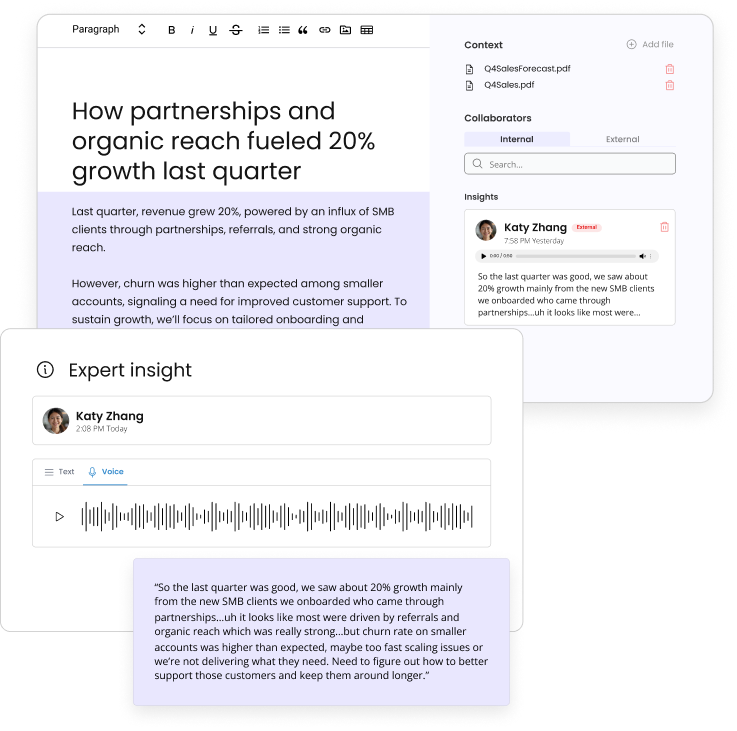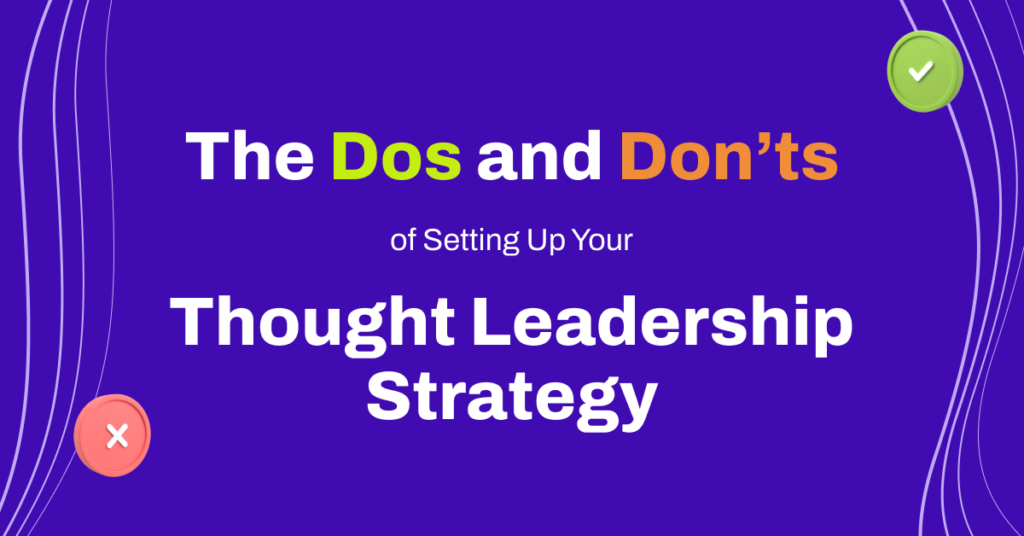Table of Contents

Authority scales when expertise comes first
Wordbrew helps teams collect expert insight before AI ever writes a word.
Built for expert-led, review-safe content
- Home
- »
- Content Marketing
- »
- The Dos and Don’ts of Setting Up Your Thought Leadership Strategy
-
Stacy Garrels
- 6 minutes read time
The Dos and Don’ts of Setting Up Your Thought Leadership Strategy
- Home
- »
- Content Marketing
- »
- The Dos and Don’ts of Setting Up Your Thought Leadership Strategy
The Dos and Don’ts of Setting Up Your Thought Leadership Strategy
Table of Contents

Thought leadership is like a cherry on top of your business. It’s the culmination of a deep understanding of your niche (which comes with experience), unique insights, and consistent effort.
But, it’s not merely as simple as writing a piece of content and slamming the publish button. There are finer details that are more sensitive and need slightly more finesse. The good news is, these are skills that can be learned.
In this in-depth guide, we’ll explore the dos and don’ts of setting up your thought leadership strategy, helping you avoid pitfalls, and maximizing your influence and reach.
TL;DR:
A successful thought leadership strategy involves:
- Defining your target audience
- Developing your unique voice
- Offering valuable insights
- Tracking the right metrics
- Creating a robust content creation and distribution plan
Alongside these core steps, steer clear of common pitfalls such as ignoring industry trends and producing overly promotional content to boost the impact of your thought leadership.
Dos of Setting Up Your Thought Leadership Strategy
Ready to embark on your thought leadership journey? Consider these essential steps for success:
- Define your target audience
Whether you are trying to establish yourself as a thought leader on LinkedIn or through a blog, you will find that there are diverse audiences with specific needs.
As such, you will need to create a well-defined target audience, tailoring down your content to appeal to a select few. This will ensure that your content resonates and builds a strong connection with the right people.
For example, Bruce Schneier, the world-renowned security technologist who runs the Schneier on Security blog, doesn’t create content for the masses. His content is targeted specifically at cybersecurity professionals, policymakers and business leaders.
Here are a few questions to consider when defining your target audience:
- Who are the key decision-makers in your industry or niche?
- What challenges and pain points do they face daily?
- What type of information are they seeking to help overcome these challenges?
By not defining your target audience, you risk creating content that doesn’t resonate with anyone, diminishing its impact and effectiveness. Conversely, once you’ve clearly defined your target audience, you can tailor your content to address their specific needs and challenges – increasing relevance, value, and impact.
- Find your voice and craft your messaging
Your voice is your unique identity in the sea of content that exists online. It sets you apart and helps you build a personal connection with your target audience.
When crafting your messaging, focus on the following elements:
- Tonality: Is your tone serious, conversational, or perhaps even humorous? Choose a style that reflects your brand’s personality and resonates with your audience.
- Authenticity: Be genuine in your communication. Share your personal experiences, beliefs, and values to forge a strong connection with your audience.
- Consistency: Ensure consistency in your messaging across all content formats and platforms. This helps reinforce your brand and makes it more memorable.
Take Apple, for instance, despite the number of new products the tech giant launches, it sticks to the voice of being simple and effective. As a result, it has helped them craft a brand that is easily recognisable.
- Offer a unique perspective
Thought leadership is centered on offering valuable insights and anecdotal advice that stems from a unique perspective.
As a thought leader, the objective is to provide guidance on challenges or industry-related issues, contributing to the ongoing conversation and driving innovation within the field.
These insights could be a result of extensive research, personal experiences, or a deep understanding of the target audience’s needs and aspirations. By sharing such valuable insights, thought leaders can help others navigate complex issues, identify trends, and make better-informed decisions.
Anecdotal advice, on the other hand, refers to sharing personal stories, experiences, and real-life examples that illustrate a particular concept or idea. These anecdotes help thought leaders create relatable, engaging, and memorable content that resonates with their audience.
For example, in this post, Arianna Huffington relates a personal story of how burnout led to a freak accident that became the catalyst for her writing her book and starting her company. By starting with a personal story, one that many who have suffered burnout can relate to, it allowed Arianna to be vulnerable and earn the trust of her audience.

- Know which metrics and KPIs to track
Unlike traditional content, thought leadership requires a different set of metrics.
Traditional content marketing often focuses on generating leads, driving website traffic, and boosting conversion rates. It often involves promoting products or services directly or indirectly through various content formats like blog posts, social media updates, and email newsletters.
In contrast, thought leadership aims to establish an individual or a brand as an authority within a specific industry or niche. The focus is on building credibility, trust, and long-term relationships with the audience. Consequently, the metrics used to gauge the success of thought leadership efforts revolve around engagement and influence.
Key performance indicators for thought leadership include:
- Engagement: Track comments, likes, and reactions to your content to gauge audience interest and involvement.
- Social shares: Monitor how often your content is shared on social media platforms. This indicates the perceived value of your insights.
- Influencer mentions: Keep track of industry leaders referencing your content or ideas, as this validates your expertise and amplifies your reach.
- Create a plan for content creation and distribution
Consider the following elements when developing your plan:
- Content formats: Diversify your content by utilizing various formats, such as blog articles, whitepapers, podcasts, and videos.
- Channels: Identify the most effective channels for reaching your target audiences, such as LinkedIn, industry forums, or guest posting on relevant websites.
- Frequency: Establish a consistent publishing schedule to maintain audience engagement and build credibility.
- Promotion: Allocate resources for promoting your content through social media, email marketing, and other relevant channels.
It is important to explore different channels that cater to specific needs and audiences. LinkedIn is an excellent platform for connecting with professionals and sharing industry insights, while Twitter is great for real-time updates and engaging in conversations around trending topics.
Take Tim Ferriss, a New York Times best-selling author, who does not stick to books to share his thoughts, for example. He regularly posts thought leadership content on LinkedIn, his blog and on Twitter to share his expertise.

He goes further out of his comfort zone of literary content by creating audio content on Spotify, through his podcast series, The Tim Ferriss Show.

To enhance your thought leadership, go beyond creating content by engaging with your audience to build trust and authority in your niche.
Don’ts of Building Your Thought Leadership Strategy
Aside from knowing what to do, it is also crucial to understand the don’ts of thought leadership. Avoid these common mistakes to give your thought leadership strategy the capacity to flourish.
- Not staying up-to-date with industry trends
For thought leadership, it’s crucial to stay informed about the latest trends and developments in your industry. It’s the foundation of establishing yourself as a knowledgeable expert while keeping your audience engaged and captivated.
This is especially important for disruptive trends as audiences look to thought leaders for guidance in times of uncertainty.
Take, for example, the recent furore over AI advancements. Here we see Pete Huang share his point of view on the acceleration of AI — sharing how the development is accelerating every day.

- Creating overly-salesy content
Though thought leadership can indirectly drive sales, your primary focus should be providing valuable insights and information.
Overly promotional content can be detrimental to your credibility and deter your audience because it often appears self-serving and inauthentic. Such content is primarily focused on selling products or services, rather than offering value to the reader or addressing their needs — making them feel as though they are being manipulated or exploited.
Instead, concentrate on educating, informing, and sharing unique perspectives to build trust and establish your expertise.
Key Takeaway
Thought leadership is a powerful marketing strategy that not only builds credibility and showcases expertise but also positions you as an authority in your industry.
Properly setting up thought leadership requires a firm understanding of your target audience and your own brand so you can create a unique voice and engaging messaging. Pair that with unique perspectives built on experience and expertise to create compelling content for your audience.
Ensure thought leadership success by tracking relevant metrics, staying current with industry trends, and avoiding salesy content. Develop a structured content plan across diverse formats and channels for maximum reach and audience trust.
FAQs
- How do you set up a thought leadership strategy?
To set up a thought leadership strategy, follow these essential steps:
- Define your target audience by understanding the key decision-makers in your industry or niche, their challenges, and the information they seek.
- Find your unique voice and craft compelling messaging that reflects your brand’s personality, maintains authenticity, and stays consistent across platforms.
- Offer unique perspectives through valuable insights and anecdotal advice, helping your audience navigate complex issues, identify trends, and make informed decisions.
- Track relevant metrics and KPIs, such as engagement, social shares, and influencer mentions, to measure the success of your strategy and refine it over time.
- Create a structured plan for content creation and distribution, utilizing various formats, channels, and promotional methods.
- What is the goal of thought leadership?
The primary goal of thought leadership is to establish yourself or your brand as an expert in a specific industry or niche, build credibility, and foster trust among your target audience. This helps in attracting and retaining customers, amplifying your reach, and ultimately driving business growth.
